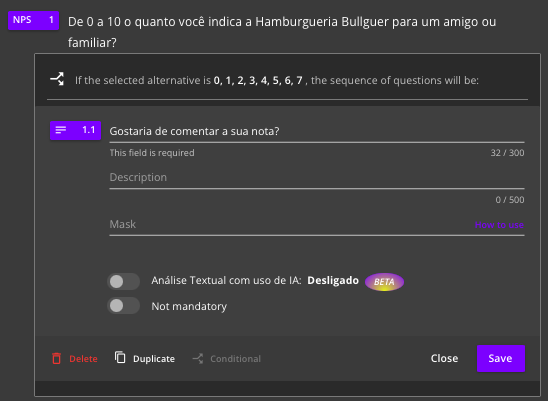Textual Analysis in Surveys
Discover how Harmo's artificial intelligence transforms your customers' feedback into actionable insights, optimizing your reputation management and customer satisfaction.
How to Access Textual Analysis in Surveys
To view the insights generated by Textual Analysis in your surveys, follow the steps below:
-
Access the Listen Section: In the side menu, navigate to the "Listen" section.
-
Select Textual Analysis: Within "Listen," click on "Textual Analysis."
-
Select Data Source: In the "Data source" filter, select "Surveys."
How to Activate Textual Analysis in your Surveys
To take advantage of Textual Analysis, you need to activate it in specific questions within your surveys, such as NPS questions. Follow the steps below:
-
Access the Surveys: Navigate to the desired surveys where you have open-ended questions.
-
Edit the Question: Click on the open-ended question (for example, an NPS question that asks for a comment) to edit it.
Activate Textual Analysis: Within the question options, locate the "Textual Analysis with AI" section and activate the option, as illustrated in the image below.

-
Save Changes: Make sure to save the changes to the question and the surveys.
By activating this feature, the textual responses collected for this specific question will be processed by artificial intelligence, providing detailed reports and valuable insights for your analysis.
Detailed Graphs and Visualizations
After activating Textual Analysis, the data collected from surveys is processed and presented in visual and intuitive reports. These graphs allow for a quick and in-depth understanding of your customers' feedback:
-
Net Sentiment Score: This graph provides an overview of the predominant sentiment in surveys, categorizing them as Positive, Neutral, and Negative. It offers a quick indicator of overall customer satisfaction, with a score ranging from -100 to 100, making it easy to identify trends and the health of your brand's reputation.
-
Net Sentiment Score (Insights): Here, Harmo's AI automatically identifies and groups the most recurring themes in open-ended responses. Topics such as "Service," "Experience," "Price," "Product," "Location," and "Store environment" are highlighted, allowing you to quickly see what matters most to your customers and which aspects are most mentioned in their surveys. Additionally, you can view the most cited units/stores for each topic.
-
Feedback: This section displays individual customer comments, along with sentiment analysis (positive, negative, neutral) and topics automatically categorized by AI. This allows for a contextualized reading of feedback, helping to understand the origin of sentiment and deepen the analysis of specific points.
-
Topic Recurrence: This scatter plot illustrates the frequency with which topics are mentioned in surveys. It helps identify which themes are most persistent and whether recurrence is decreasing or increasing, providing insight into the ongoing relevance of each issue for customers.
-
Sentiment Change: Similar to the recurrence graph, this scatter plot focuses on the variation of sentiment for topics over time. It indicates whether the sentiment regarding a specific topic is becoming more positive or negative, allowing for proactive intervention in critical areas.
-
Topic Evolution: This graph shows the evolution of sentiment (Positive, Neutral, Negative) for a specific topic over time (monthly, semi-annual, or annual). It is a powerful tool to monitor the impact of actions and identify whether customers' perception of a particular aspect is improving or worsening. It also highlights the stores with the highest complaint and satisfaction rates for the selected topic.
Action Plan: Harmo's Differentiator
One of Harmo's great differentiators in Textual Analysis is the ability to generate an Action Plan based on the insights obtained. This functionality transforms analyzed data into practical and strategic recommendations, allowing you to:
-
Prioritize Improvements: Identify areas that require immediate attention based on sentiment and topic frequency.
- Make Strategic Decisions: Use recommendations to improve products, services, and customer experience.
- Monitor Progress: Track the effectiveness of implemented actions and adjust your strategy as needed.
